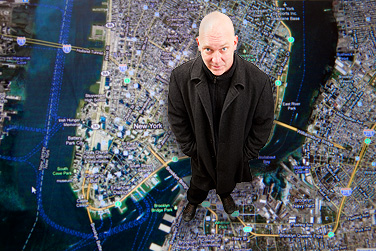Close Up
Linking technology to the urban landscape

Mark Shepard investigates the implications of mobile and other situated technologies on urban space. Photo: DOUGLAS LEVERE
-
 Print
Print -
 Comments
Comments
-
“Mobile and other situated technologies are increasingly part of the material world that we move through.”
In the mobile age, iPhones, iPods and BlackBerrys often distance users from their direct surroundings—think of the teenager who never travels without headphones, or the businesswoman checking e-mail over lunch.
But is the technology isolating by nature?
Mark Shepard, assistant professor of architecture and media study, says the answer is “no.” How the technologies shape us and our surroundings depends, he says, on how we choose to use them.
A media architect and researcher, Shepard joined the UB faculty in 2005 and has spent the years since investigating the implications of mobile and other situated technologies on urban space.
In 2006, he partnered with colleagues, including Omar Khan, an associate professor of architecture, to organize a three-day symposium that brought together researchers and practitioners in art, architecture, technology and sociology to explore the emerging role of situated technologies in the design and inhabitation of the modern city.
“Toward the Sentient City,” an Architectural League of New York exhibition Shepard curated in 2009, explored the same issues.
Since arriving at UB, Shepard has received more than $75,000 in grants to develop a “Sentient City Survival Kit,” an ongoing project exploring the social, cultural and political implications of ubiquitous computing for urban environments.
The work aims to raise awareness of implications for privacy, autonomy, trust and serendipity in a society where computing is spilling from the desktop out onto the sidewalks, streets and public spaces of urban environments.
An entry on Shepard’s Sentient City Survival Kit blog outlines the varied ways people may react to new situated technologies, underscoring the importance of studying and thinking critically about these technologies’ effect on urban environments.
“Few may quibble about ‘smart’ traffic light control systems that more efficiently manage the ebbs and flows of trucks, cars and buses on our city streets,” Shepard writes. “Some may be irritated when discount coupons for their favorite espresso drink are beamed to their mobile phone as they pass by Starbucks. Many are likely to protest when they are denied passage through a subway turnstile because the system ‘senses’ that their purchasing habits, mobility patterns and current galvanic skin response (GSR) reading happen to match the profile of a terrorist.”
Two of Shepard’s most recent projects encourage city dwellers to leverage their cell phones as tools for discovery as they navigate city streets and other public spaces.
The first, Serendipitor, is a navigation app Shepard developed for the iPhone, iPad and iPod touch. The program, part of the Sentient City Survival Kit, is Google Maps with a twist.
Users enter an origin and destination, and adjust the complexity of the recommended route to fit their schedule and preferences. Serendipitor then generates step-by-step directions punctuated by surprising instructions: Pick a stranger and follow that person for a few blocks, for instance, or go to the nearest flower shop, buy a flower and give it to a passerby.
Shepard’s “Tactical Sound Garden,” a second program, allows users of mobile devices to “plant” and “prune” sounds in WiFi hot zones, creating community sound gardens in urban spaces.
“Mobile and other situated technologies are increasingly part of the material world that we move through,” says Shepard, an editor of the Architectural League of New York’s Situated Technologies Pamphlets Series. “Corporate interests, government and law enforcement agencies are taking advantage of these new technologies. But what are some of the other opportunities that exist for the future of urban space?”
“The sound garden draws on the culture of urban community gardening to shape the sonic topography of cities in a collaborative way,” Shepard says. “Serendipitor is more for the individual. It encourages you to look around you, to be more aware of your surroundings. It assists with navigation, but really, it’s designed to help you find something by looking for something else.”
In an emerging field, Shepard’s work has generated plenty of buzz.
Serendipitor is one of seven nominees for the transmediale Award 2011, a prestigious digital and media arts award whose international jury received more than 1,000 submissions. Shepard is exhibiting the program this month at the Art Center Nabi in Seoul, Korea. More than 1,000 people have downloaded the free app.
Shepard’s sound gardens have been similarly successful, making appearances at museums, festivals and art events in cities in the United States, Europe and South America. He currently is in São Paulo, Brazil, where one of his sound gardens is featured in the Vivo ARTE.MOV festival, which opened on Nov. 30.

Reader Comments